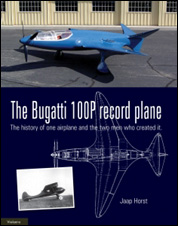Le nom d’Ettore Bugatti est indissociablement lié à l’automobile. Les véloces 35B et 57G, les éblouissantes 41, 50, 55… ont laissé une profonde empreinte dans l’histoire de l’automobile. Mais Ettore Bugatti n’était pas qu’un motoriste talentueux et un constructeur d’automobiles hors normes : outre le chemin de fer (les autorails Bugatti) et la motorisation de bateaux de compétition, il comptait bien mettre son souffle novateur et sa passion pour la vitesse au service de l’aviation. C’est ainsi que naquit le projet d’avion de record Bugatti 100P.
Époustouflant, tant dans ses formes que dans les solutions techniques retenues, le Bugatti 100P était destiné à conquérir le record du monde de vitesse. Étonnante machine qui aurait sans doute marqué l’histoire de l’aviation si la Seconde Guerre mondiale et l’arrivée des troupes allemandes n’avait brisé son élan.
Voilà donc ce qui sert de pivot à cet ouvrage. Pivot, effectivement, car le livre n’est pas exclusivement dédié au 100P : un avion qui n’a jamais volé, des archives assez peu volumineuses, il était nécessaire d’étoffer le sujet. Ainsi donc, le titre n’est pas très complet, car sur les 216 pages de l’ouvrage, plus de la moitié sont dédiés aux « à-côtés » de l’appareil.
Un premier chapitre est consacré à l’avion, à son histoire ainsi qu’à ses caractéristiques qui ne manqueront pas d’intéresser les mordus de mécanique. Le second, intitulé « Ettore Bugatti », n’est pas à proprement parler une biographie, mais une évocation documentée des travaux de motoriste du « Maître de la vitesse » ainsi que de ses diverses implications dans d’autres ateliers que les siens. Apparaît ensuite un personnage-clé dans cette histoire extraordinaire : Louis de Monge, ingénieur belge dont le lecteur connaît le nom s’il s’est intéressé aux ailes volantes de chez Dyle & Bacalan. Le dernier (court) chapitre, « In the air, at last ! », est une évocation assez brève du projet de réplique volante du 100P.
Il s’agit donc d’un ouvrage très original, traitant en profondeur d’un sujet peu commun. Certains pourraient formuler à Jaap Horst le reproche de s’éloigner du sujet, ce que nous ne ferons pas : un tel appareil méritait des explications quant au contexte de sa construction. L’auteur est parfois un peu loin du Bugatti 100P, mais reconnaissons que ses propos connexes ne manquent pas d’intérêt. L’auteur a visiblement écumé toute l’iconographie disponible et le livre jouit d’un bel équilibre entre le texte et l’image. Un beau livre pour amateurs éclairés… ou amoureux de la mécanique.
Philippe Ballarini
240 pages, 22 x 28,5 cm, relié
1,306 kg
La page web de Jaap Horst
Ettore Bugatti’s name is inextricably linked to the automobile. The swift 35B and 57G, and the dazzling 41, 50 and 55, have undeniably made their mark on automobile history. However, Ettore Bugatti was not merely a talented engine-maker and extraordinary car-builder! He also built railcars and speedboat engines, and brought his innovative insight to the field of aviation. Driven by a passion for speed, he initiated the Bugatti 100P record-breaking aircraft project.
The Bugatti 100P, built to conquer the world record for speed, was visually and technically mind-blowing. This amazing machine would probably have made aviation history, had the Second World War and the arrival of German troops not broken its momentum.
So here we are at the focal point of this book, which is not dedicated exclusively to the 100P. Indeed, the plane never flew and generated little in the way of archives, so the subject needed expansion. Hence, the title is incomplete; more than half of the book’s 216 pages are dedicated to “related topics”.
The first chapter is devoted to the plane itself, its history and features – the latter will certainly be of interest to mechanics fans. The second chapter, entitled “Ettore Bugatti” is not, strictly speaking, a biography but rather a documented reminder of the work of the “Master of Speed” on engines, as well as his involvement in various other workshops than his own. Then a key figure arrives on the scene of this amazing story. It is Louis de Monge, a Belgian engineer who is known to those readers interested in the flying machines of Dyle & Bacalan. The last (short) chapter, entitled “In the air, at last!” is a brief description of the project for a flying replica of the 100P.
We should note the originality of this publication which offers an in-depth handling of a rather unusual subject. While some might complain that Jaap Horst deviates from the subject, we feel that such an aircraft deserves the explanations on its background and construction. The author is sometimes a little distant from the Bugatti 100P, but we should appreciate that his related remarks are not without interest. The author has evidently used every available illustration, giving the book a good balance between text and image. This is a fine book for informed fans, and lovers of mechanics!
Philippe Ballarini
Translation by Lynn Dubile
240 pages, 22 x 28,5 cm, hardcover
1,306 kg
Jaap Horst’s web page



